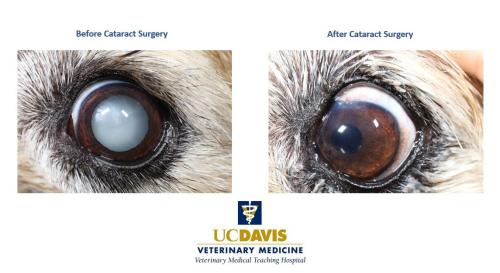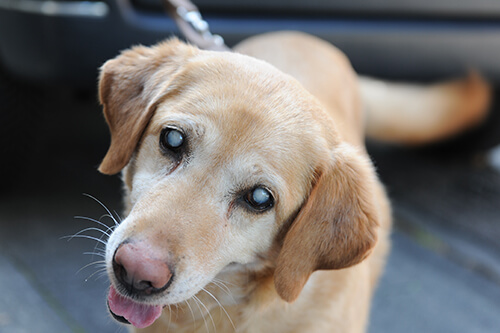Yes, a diabetic dog can go blind overnight. This sudden blindness is often due to cataracts, which are common in diabetic dogs.
Diabetes in dogs is a serious condition that affects their vision. Cataracts can form quickly, leading to sudden blindness. This can be alarming for pet owners. Understanding the link between diabetes and vision loss is crucial. It helps in managing the condition better.
Diabetic dogs need regular check-ups. Early detection and treatment can prevent or delay blindness. Learn more about how diabetes impacts your dog’s eyes and what you can do to help them. Knowing the signs and treatments can make a big difference in your pet’s quality of life.
Diabetes In Dogs
Diabetes in dogs is a serious condition. It affects many pets worldwide. Just like humans, dogs can develop diabetes too. This disease can impact their quality of life. It can lead to other health issues if not managed properly.
One significant complication of diabetes in dogs is blindness. High blood sugar levels can damage the eyes. This can cause sudden vision loss. Understanding the signs and getting a proper diagnosis is crucial.
Common Symptoms
Look out for increased thirst in your dog. Drinking more water than usual is a key sign. Frequent urination is another symptom. Your dog may also lose weight rapidly. Even with a good appetite, weight loss can occur.
Your pet may seem more tired than usual. Lethargy is common in diabetic dogs. Cloudy eyes can also indicate diabetes. These symptoms need immediate attention. Early detection can help manage the disease better.
Diagnosis Process
Visit your vet if you notice any symptoms. The vet will conduct a physical exam. They will check your dog’s weight and overall health. Blood and urine tests are essential. These tests measure glucose levels. High glucose levels confirm diabetes.
Your vet may also check for other health issues. Sometimes, additional tests are needed. These help in understanding the extent of the disease. Early diagnosis is key to effective management. It can prevent complications like blindness.

Credit: www.vetmed.ucdavis.edu
Impact Of Diabetes On Vision
Diabetes can have a serious impact on your dog’s vision. The condition can lead to various eye problems, and in severe cases, blindness. Understanding how diabetes affects the eyes and recognizing the signs of vision problems can help you take timely action to protect your dog’s eyesight.
How Diabetes Affects Eyes
Diabetes affects your dog’s eyes by causing changes in blood sugar levels. High blood sugar can damage blood vessels in the eyes. This damage can lead to cataracts, which cloud the eye lens. It can also cause glaucoma, which increases pressure in the eye. Both conditions can severely impact vision.
Signs Of Vision Problems
Watch for signs of vision problems in your diabetic dog. They may bump into furniture or walls. They might be hesitant to move in unfamiliar places. You may notice cloudy eyes, which can indicate cataracts. Redness or swelling can signal glaucoma. If your dog seems more anxious or is reluctant to go outside, it may be struggling with vision loss. Early detection can make a big difference.
Sudden Blindness In Diabetic Dogs
Sudden blindness in diabetic dogs is a topic that can be quite distressing for pet owners. Imagine waking up to find your furry friend bumping into furniture and struggling to navigate their environment. This unexpected change can be alarming. Understanding the causes and learning from real-life examples can help you better care for your diabetic dog and possibly prevent such occurrences.
Causes Of Sudden Blindness
There are several reasons why a diabetic dog might suddenly go blind. One of the most common causes is diabetic cataracts. This happens when high blood sugar levels cause changes in the lens of the eye, making it cloudy and impairing vision. Another possible cause is retinal detachment, which can occur due to uncontrolled diabetes leading to high blood pressure and damaging the retina.
Other causes include:
- Glaucoma: Increased pressure in the eye can damage the optic nerve.
- Sudden Acquired Retinal Degeneration Syndrome (SARDS): This condition causes rapid vision loss.
- Optic neuritis: Inflammation of the optic nerve can lead to sudden blindness.
Early diagnosis and treatment can sometimes prevent or slow down these conditions, so regular veterinary check-ups are crucial for diabetic dogs.
Case Studies And Examples
Let’s look at some real-life examples to understand how sudden blindness in diabetic dogs can manifest and be managed.
| Case Study | Details |
|---|---|
| Case 1: Bella | Bella, a 7-year-old Labrador, developed cataracts almost overnight. Her owner noticed she was hesitant to climb stairs and seemed disoriented. A quick visit to the vet confirmed diabetic cataracts. With timely surgery, Bella regained partial vision. |
| Case 2: Max | Max, a 5-year-old Poodle, suddenly went blind due to retinal detachment. His owner had missed a few insulin doses, leading to uncontrolled diabetes. Although Max’s vision couldn’t be restored, his owner learned to create a safe and familiar environment for him to navigate. |
These cases highlight the importance of consistent diabetes management and regular vet visits. While sudden blindness can be shocking, early intervention can sometimes reverse or manage the condition, ensuring your pet still enjoys a good quality of life.

Credit: www.lapoflove.com
Early Detection And Prevention
Early detection and prevention are key to managing a diabetic dog’s health. If left unchecked, diabetes can lead to severe complications, including blindness. By staying vigilant and proactive, you can help prevent such outcomes and ensure a better quality of life for your furry friend.
Monitoring Blood Sugar Levels
Regularly checking your dog’s blood sugar levels is crucial. Consistent monitoring helps you keep track of any changes. It also allows for timely adjustments to their diet or medication. This vigilance is essential in preventing spikes or drops in blood sugar. Both can cause serious health issues, including blindness.
Regular Veterinary Check-ups
Take your dog for regular veterinary check-ups. These visits are vital for early detection of any complications. Your vet can provide guidance on managing diabetes. They can also spot signs of potential problems before they become severe. This helps in preventing sudden blindness and other issues.
Treatment Options For Diabetic Dogs
When your furry friend is diagnosed with diabetes, it can feel like a storm cloud just covered your sunny day. But don’t worry, there are many ways to manage this condition and ensure your pet lives a happy life. Let’s dive into some effective treatment options that can help.
Medications And Insulin
One of the most crucial steps in managing diabetes in dogs is through medications and insulin. Just like humans, diabetic dogs need insulin to regulate their blood sugar levels. Your vet will prescribe the right type and dosage of insulin for your dog.
- Insulin Injections: These are usually given twice a day. It sounds daunting, but with practice, it becomes a routine.
- Oral Medications: In some cases, dogs might be prescribed oral medications to help control blood sugar.
Remember, it’s essential to monitor your dog’s blood sugar levels regularly. This can help you and your vet make necessary adjustments to the treatment plan.
Diet And Lifestyle Changes
Diet plays a significant role in managing diabetes. A balanced diet helps maintain stable blood sugar levels. Here are some tips:
- High Fiber Foods: Foods rich in fiber can help regulate blood sugar.
- Consistent Feeding Schedule: Feed your dog at the same times every day to maintain steady blood sugar levels.
- Avoid Sugary Treats: Treats with high sugar can cause spikes in blood sugar levels. Opt for healthier alternatives.
In addition to diet, regular exercise is vital. It helps your dog maintain a healthy weight and can improve their insulin sensitivity. Something as simple as a daily walk can make a big difference.
In summary, while managing diabetes in dogs might require some adjustments, with the right medications, a balanced diet, and regular exercise, your furry friend can lead a happy and healthy life. So, don’t let those storm clouds get you down—there’s a rainbow waiting just around the corner.

Credit: mcgeheeclinic.com
Managing A Blind Diabetic Dog
Managing a blind diabetic dog can feel overwhelming, but it’s a challenge many pet owners successfully navigate. When diabetes leads to sudden blindness in dogs, it’s crucial to adapt their environment and routines to ensure they continue to live a happy, fulfilling life. Let’s dive into some practical steps for managing a blind diabetic dog.
Home Adaptations
Creating a safe and comfortable home environment is essential for a blind diabetic dog. Here are some tips:
- Keep things in place: Dogs rely heavily on their memory of their surroundings. Avoid moving furniture or their belongings around.
- Use scent markers: Placing different scents in each room can help your dog navigate your home.
- Install baby gates: These can prevent your dog from falling down stairs or entering unsafe areas.
- Provide textured mats: Different textures can indicate certain areas, like their bed or food bowl.
Training And Support
Training and consistent support are key to helping your dog adjust. Here’s how you can assist:
- Use verbal cues: Teach commands like “step up” or “step down” to guide them through obstacles.
- Leash training: A leash can help you guide them safely during walks and provide reassurance.
- Positive reinforcement: Reward them with treats and praise to encourage confidence and learning.
Support from a professional trainer can also be invaluable. They can offer personalized strategies to help your dog adapt.
Remember, patience is key. Every dog adapts at their own pace. With love and support, your blind diabetic dog can enjoy a wonderful life.
Veterinary Support And Resources
It’s heartbreaking to think about your furry friend going blind overnight due to diabetes. But don’t worry, you’re not alone in this. There are many veterinary support systems and resources available to help you and your dog. Let’s explore some of the key supports you can rely on to navigate this challenging time.
Finding The Right Vet
First and foremost, finding the right vet is crucial. Not all vets are created equal, and it’s important to find one who specializes in diabetes management for pets. A good vet will not only treat your dog but also educate you about the condition and its implications.
- Ask for Recommendations: Talk to other pet owners. They can provide valuable insights and recommend trusted vets.
- Check Credentials: Ensure the vet is certified and has experience treating diabetic pets.
- Evaluate Communication: Your vet should be approachable and willing to answer all your questions.
Remember, the right vet can make all the difference in your pet’s quality of life.
Support Groups And Forums
Sometimes, the best advice comes from those who have walked a mile in your shoes. Support groups and forums can be a goldmine of information and emotional support.
Here are a few tips to get the most out of these resources:
- Join Active Groups: Look for groups with regular posts and active members. These communities are more likely to provide timely support.
- Participate: Don’t be a silent observer. Ask questions, share your experiences, and engage with other members.
- Verify Information: While peer advice is valuable, always cross-check medical information with your vet.
Support groups can offer a sense of community and reassurance that you’re not alone in this journey.
Utilizing Online Resources
In today’s digital age, there’s a wealth of information online. Websites, blogs, and social media channels dedicated to pet diabetes can provide useful tips and updates.
| Resource | Description |
|---|---|
| Pet Diabetes Wiki | A comprehensive resource for managing pet diabetes, with articles and user contributions. |
| Diabetic Pets Facebook Group | A community of pet owners sharing their experiences and offering support. |
Always ensure the information is from a credible source before applying it to your dog’s care.
In summary, you’re not alone in managing your dog’s diabetes. With the right vet, supportive communities, and reliable online resources, you can ensure your furry friend gets the best care possible. So, take a deep breath, and know that help is just a click or a call away.
Success Stories And Hope
Seeing your diabetic dog go blind overnight can be heart-wrenching. Yet, there is hope. Many pet owners have shared their success stories. These stories are filled with inspiration and practical advice. Long-term management tips can help your dog live a happy life. Let’s explore some of these uplifting tales and useful tips.
Inspiring Recovery Stories
One pet owner, Jane, noticed her dog, Max, struggling to see. She took Max to the vet immediately. With the right treatment, Max’s vision improved over time. Jane’s dedication and timely action made all the difference. Max now enjoys playing and walking just like before.
Another story is about Sam and his dog, Bella. Bella lost her sight due to diabetes. Sam didn’t give up. He researched and found a vet specializing in diabetic dogs. With proper care, Bella regained partial sight. Sam’s persistence paid off, and Bella is now more active and happy.
Long-term Management Tips
Regular vet visits are crucial. They help monitor your dog’s blood sugar levels. A balanced diet is also important. Feed your dog high-quality, low-carb food. Consistent exercise keeps your dog fit and helps manage diabetes.
Medication adherence is key. Follow your vet’s instructions carefully. Insulin shots should be given as prescribed. Keep a schedule and set reminders if needed. Regular eye check-ups can prevent sudden blindness. Early detection of issues can save your dog’s sight.
Creating a safe environment at home helps too. Remove obstacles to prevent accidents. Use rugs to help your dog navigate. Train your dog to respond to sounds for guidance. Patience and love go a long way in managing your dog’s condition.
Frequently Asked Questions
Should I Put My Blind Diabetic Dog Down?
Consult your vet before making any decisions. Many blind diabetic dogs can still live happy, fulfilling lives with proper care.
How Quickly Do Dogs With Diabetes Go Blind?
Dogs with diabetes can go blind within 6 months to a year. Regular vet check-ups and proper care can help.
Why Did My Dog Go Blind Overnight?
Your dog may go blind overnight due to sudden acute retinal degeneration syndrome (SARDS), glaucoma, or retinal detachment. Consult a veterinarian immediately for diagnosis and treatment.
Can Diabetic Blindness In A Dog Be Reversed?
Diabetic blindness in dogs is often irreversible. Early detection and treatment can help manage diabetes and prevent blindness. Consult your vet.
Conclusion
A diabetic dog can go blind overnight. Swift action is essential. Regular vet check-ups help catch issues early. Monitor your dog’s symptoms closely. Proper diet and medication can manage diabetes. Early intervention prevents sudden blindness. Pet health is a priority.
Always stay vigilant.